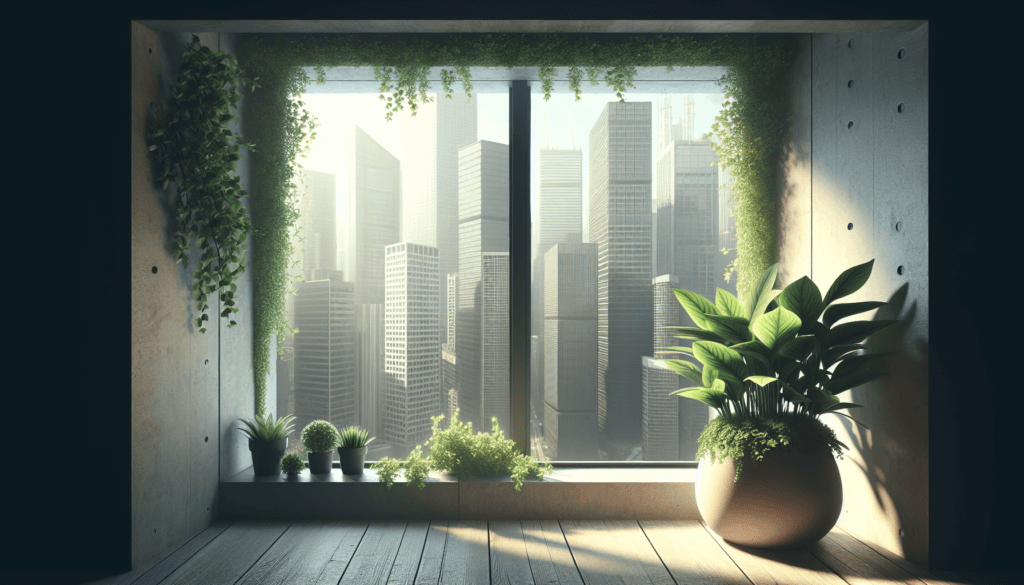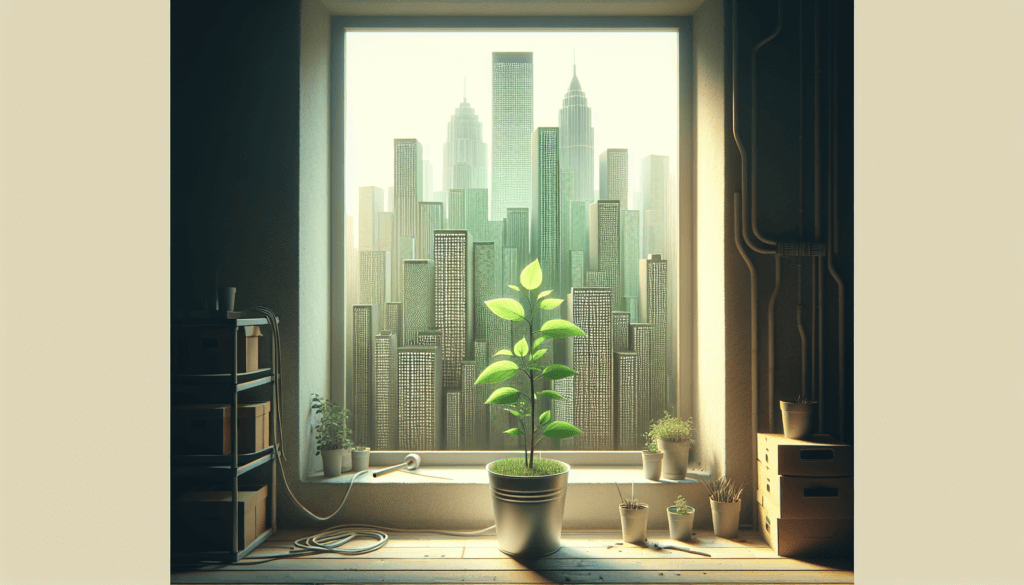Looking to start your own urban garden but don’t have much space to work with? Look no further! In this article, we’ll show you just how easy it can be to begin your own green oasis in the midst of a concrete jungle. Whether you have a small balcony, a tiny backyard, or even just a windowsill, we have tips, tricks, and creative ideas to help you get started on your urban gardening journey. With a little bit of planning and some clever techniques, you’ll be growing your own fresh herbs, veggies, and even fruits in no time at all. Let’s get started!

Choose the Right Plants
Assess your space
When starting an urban garden in a small space, the first step is to assess your available space. Take a look at your balcony, patio, or any other area you have designated for your garden. Consider the size and layout of the space, as well as any potential limitations such as shade or limited sunlight. By understanding the dimensions and characteristics of your space, you can determine the types and quantities of plants that will thrive in your garden.
Consider your climate
Another important factor to consider when choosing plants for your urban garden is your climate. Different plants have different temperature and humidity requirements, so it is crucial to select varieties that can thrive in your specific climate. Research the average temperature and precipitation in your area, and look for plants that are known to be well-suited to your climatic conditions. This will ensure that your garden has the best chance of success.
Select plants suited for small spaces
When working with limited space, it is essential to choose plants that are well-suited for small gardens. Look for varieties that are compact and have a bushy or trailing growth habit. This will allow you to maximize the use of vertical space and create a lush garden even in a small area. Some excellent options for small spaces include herbs, cherry tomatoes, lettuce, strawberries, and dwarf varieties of vegetables. These plants not only require less space but also have the added benefit of being easily harvestable.
Evaluate Available Sunlight
Determine the sun exposure
Sunlight is a critical factor in the success of any garden. Take the time to determine the sun exposure in your designated gardening area. Observe how the sun moves throughout the day, noting which areas receive full sun, partial shade, or full shade. This information will help you choose the right plants for each location in your garden, as some plants require full sun while others prefer shade.
Identify ideal locations for plants
Based on your assessment of sun exposure, identify the ideal locations for your plants. Place sun-loving plants in areas that receive the most sunlight and shade-loving plants in areas with lower light levels. By strategically placing your plants, you can maximize their growth potential and create a harmonious garden where each plant thrives in its designated spot.

Prepare the Soil
Test the soil
Before you start planting, it is important to test the soil in your urban garden. Soil tests can determine pH levels, nutrient deficiencies, and other factors that may affect plant growth. You can purchase soil testing kits or send samples to a local agricultural extension office for analysis. Once you have the results, you can make informed decisions about soil amendments and fertilizers to ensure the optimal conditions for your plants.
Amend the soil with organic matter
To improve the quality of your soil, consider adding organic matter. Organic matter, such as compost or well-rotted manure, can enrich the soil, enhance its nutrient content, and improve its overall structure. Mix the organic matter into the existing soil, creating a nutrient-rich foundation that will support healthy plant growth. This step is especially important in urban settings where the soil may be depleted or heavily compacted.
Ensure proper drainage
In small urban gardens, proper drainage is crucial to prevent waterlogging and root rot. Ensure that your gardening area has adequate drainage by creating raised beds or using containers with drainage holes. If the soil in your garden area is heavy or poorly draining, you may need to improve drainage by adding sand or organic matter to the soil. Good drainage will help your plants thrive by preventing oversaturation and allowing the roots to access oxygen.
Decide on Containers
Choose the right size containers
When gardening in a small space, containers can be a great solution. Choose containers that are appropriate for the size of your plants, ensuring they have enough space for root growth. Smaller plants, like herbs or lettuces, can thrive in smaller containers, while larger plants, like tomatoes or peppers, may require larger pots. Consider the mature size of your plants and choose containers that will accommodate their growth over time.
Consider materials for containers
Container gardening allows for versatility and creativity in choosing materials for your pots. Options include traditional clay or terracotta pots, lightweight plastic pots, or even repurposed containers such as old buckets or barrels. Each material has its pros and cons, so consider factors such as aesthetics, durability, and water retention when choosing containers for your urban garden.
Ensure adequate drainage in containers
Proper drainage is essential for container gardening success. Ensure that your containers have drainage holes at the bottom to allow excess water to escape. Without proper drainage, water can accumulate at the bottom of the container, leading to root rot and other issues. Provide a layer of gravel or broken pottery shards at the bottom of the containers to prevent the drainage holes from becoming blocked by soil.

Select the Right Gardening Techniques
Vertical gardening
In small urban spaces, vertical gardening is an excellent technique to maximize growing area. Vertical gardening involves growing plants on structures such as trellises, walls, or fences, allowing them to climb and take up less ground space. This technique is ideal for vining vegetables like beans or cucumbers, as well as for ornamental plants such as ivy or flowering vines. Vertical gardening not only saves space but also adds visual interest to your urban garden.
Container gardening
Container gardening is a popular choice for urban gardeners, as it allows for flexibility and mobility. With container gardening, you can create small individual gardens throughout your space. This technique is particularly useful for growing herbs, lettuces, and small vegetables. Container gardening allows you to adapt your garden to different light conditions by moving the containers as needed.
Window box gardening
Window box gardening is a great solution for urban dwellers with limited outdoor space. Placing window boxes on windowsills or balcony railings can create a charming and practical garden display. Choose plants with shallow root systems, such as herbs or pansies, and enjoy a beautiful garden right outside your window.
Hydroponics
For those looking for an innovative gardening technique, hydroponics is worth considering. Hydroponics involves growing plants in nutrient-rich water, without soil. This method is ideal for small urban spaces, as it maximizes water and nutrient efficiency while minimizing the need for soil. With hydroponics, plants can be grown vertically or horizontally, making it a versatile option for urban gardeners.
Aquaponics
Aquaponics combines hydroponics with aquaculture, creating a closed-loop system where plants and fish mutually benefit each other. In this system, fish waste provides nutrients for the plants, while the plants filter and purify the water for the fish. Aquaponics can be implemented in small urban spaces and is an environmentally friendly and efficient way to grow both food and ornamental plants.
Watering and Irrigation
Determine watering needs
Proper watering is essential for the health and growth of your plants. Different plants have different watering needs, so it is important to understand the specific requirements of the plants in your urban garden. Research the watering needs of each plant variety and develop a watering schedule that provides the right amount of moisture without overwatering or underwatering.
Choose appropriate watering methods
There are several watering methods that can be used in an urban garden. Consider options such as hand-watering with a watering can or hose, drip irrigation systems, or self-watering containers. Each method has its advantages and disadvantages, so choose the method that best suits your needs and the needs of your plants. Additionally, make sure to water during the cooler parts of the day to reduce evaporation and water loss.

Provide Adequate Nutrients
Fertilize regularly
To ensure that your plants receive the necessary nutrients for healthy growth, regular fertilization is essential. Choose a balanced fertilizer or a formula specific to the needs of your plants, and follow the manufacturer’s instructions for application rates. Regular fertilization will help your plants stay vibrant and productive throughout the growing season.
Use natural and organic fertilizers
For those looking to minimize their environmental impact, natural and organic fertilizers are a great choice. These fertilizers are derived from organic materials such as compost, animal manure, or plant-based sources. They provide a slow release of nutrients and contribute to the overall health of the soil. Using natural and organic fertilizers is not only beneficial for your plants but also for the ecosystem of your urban garden.
Consider composting
Composting is a sustainable practice that can benefit both your urban garden and the environment. Start a compost bin or use a small composting system specifically designed for urban spaces. Composting allows you to recycle kitchen scraps and yard waste, turning them into nutrient-rich soil amendment for your plants. Incorporating compost into your garden beds or containers will improve soil fertility and promote healthy plant growth.
Control Pests and Diseases
Identify common pests and diseases
Even in urban gardens, pests and diseases can pose a threat to the health of your plants. Identify common pests and diseases in your area and familiarize yourself with their signs and symptoms. This knowledge will help you promptly recognize and address any issues that may arise in your garden.
Implement preventive measures
Prevention is key when it comes to controlling pests and diseases. Take steps to minimize the risk of infestations or infections by practicing good garden hygiene. Regularly remove weeds and debris, sanitize your tools, and rotate your crops. By implementing these preventive measures, you can reduce the likelihood of encountering pest and disease problems in your urban garden.
Use natural pest control methods
In an urban garden, it is important to prioritize natural pest control methods that are safe for the environment and human health. Consider using techniques such as companion planting, introducing beneficial insects, or making homemade organic pest sprays. These approaches can effectively control pests while minimizing the use of harmful chemicals.

Maintain and Harvest
Regularly monitor and maintain the garden
To ensure the ongoing health and success of your urban garden, it is essential to regularly monitor and maintain it. Check your plants for signs of nutrient deficiencies, pests, or disease and take appropriate action when necessary. Deadhead spent flowers, remove weeds, and provide additional support to plants that need it. By being attentive to your garden’s needs, you can address issues early on and keep your plants thriving.
Prune and trim plants as needed
Pruning and trimming are important maintenance tasks in an urban garden. Prune plants to remove dead or damaged branches and to promote healthy growth. Additionally, trim plants that tend to become leggy or overgrown, helping them maintain a compact and attractive appearance. Regular pruning and trimming will not only benefit the plants but also contribute to the overall aesthetics of your garden.
Harvest the produce at the right time
One of the most rewarding aspects of urban gardening is harvesting fresh produce. Pay attention to the specific harvesting requirements of each plant variety and harvest your fruits, vegetables, or herbs at the right time. Harvesting too early or too late can impact the flavor and quality of your produce. Enjoy the satisfaction of picking ripe, homegrown produce and reap the rewards of your hard work.
Seek Community Support
Join local gardening clubs or communities
Gardening can be a solo activity, but joining local gardening clubs or communities can greatly enhance your urban gardening experience. These groups provide opportunities to connect with fellow gardeners, share knowledge and resources, and exchange valuable tips and advice. Being part of a gardening community creates a sense of camaraderie and support that can make your urban gardening journey even more enjoyable.
Participate in farmer’s markets or community gardens
If you have surplus produce from your urban garden, consider participating in local farmer’s markets or community gardens. Farmer’s markets provide a platform to sell or trade your homegrown produce, connecting you with your community and potentially generating income. Community gardens offer shared spaces where you can grow alongside fellow urban gardeners, fostering a sense of community and collaboration.
Share knowledge and resources with others
As an urban gardener, you have valuable knowledge and resources to share with others. Take the opportunity to share your gardening experiences, tips, and tricks with friends, neighbors, or even online communities. By sharing your knowledge, you can inspire others to start their own urban gardens and contribute to the growth of the urban gardening movement.
Starting an urban garden in a small space may seem challenging, but with proper planning and the right techniques, it is entirely achievable. Assess your space, evaluate sunlight exposure, prepare the soil, choose appropriate containers, and select the right gardening techniques. Provide adequate watering, nutrients, and pest control, and be diligent in maintaining and harvesting your garden. Seek support from the community, join gardening clubs, and share your knowledge with others. With these steps, you can cultivate a thriving urban garden in even the smallest of spaces. Happy gardening!


